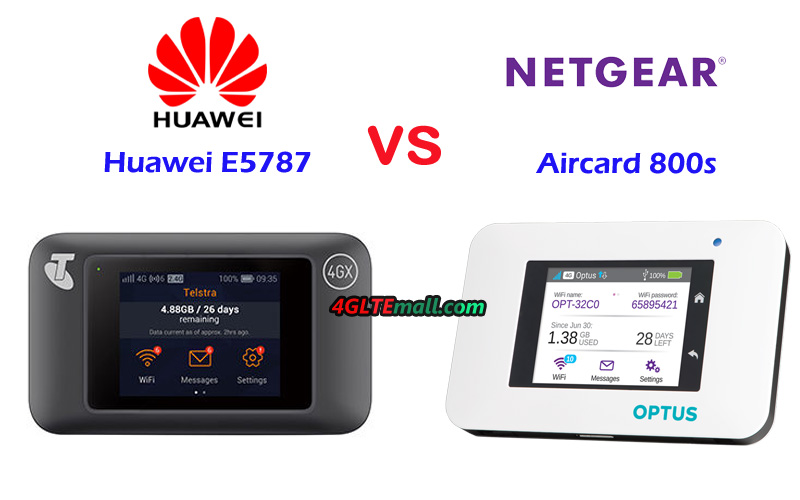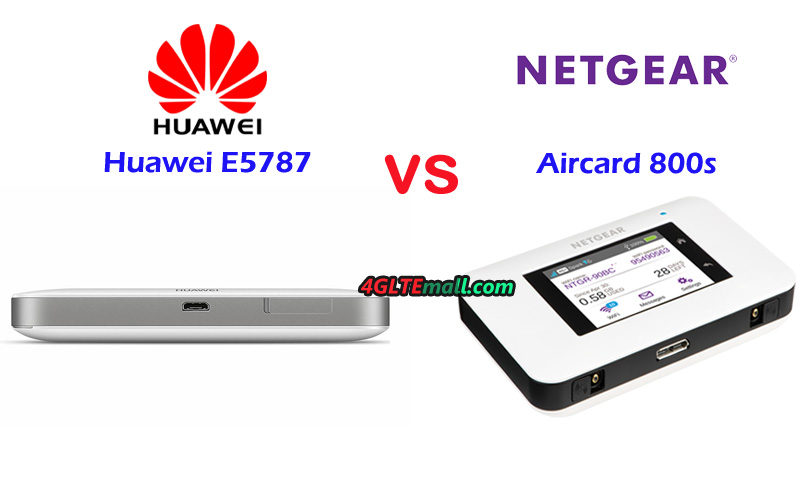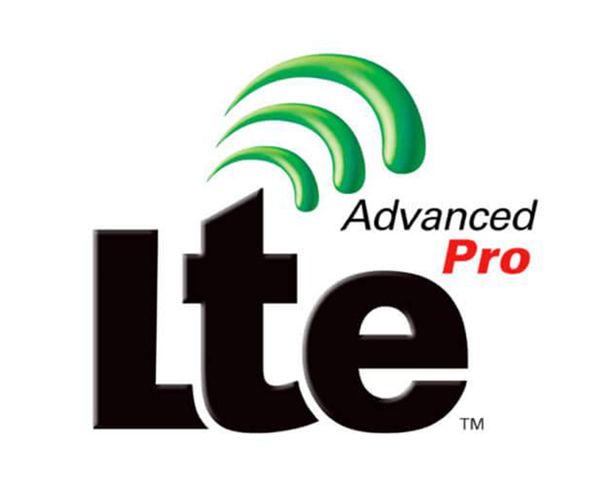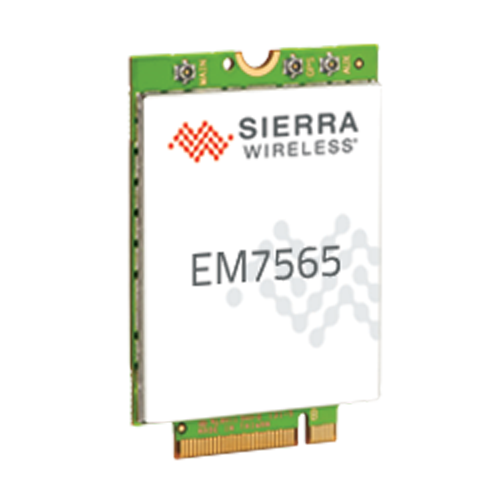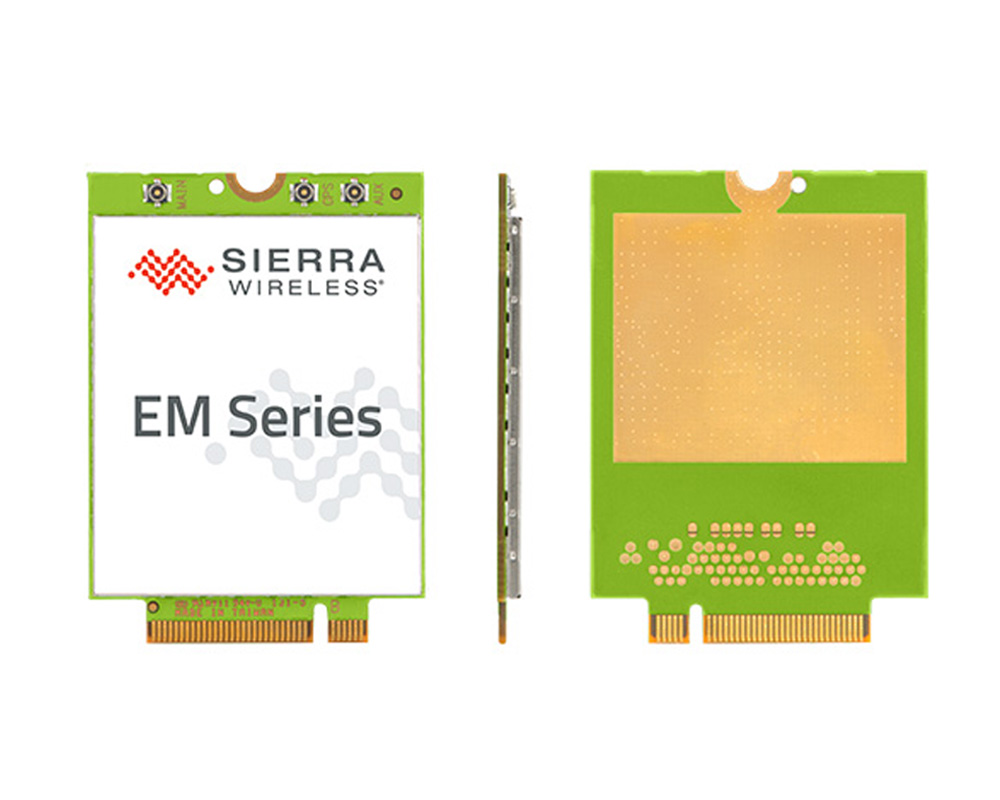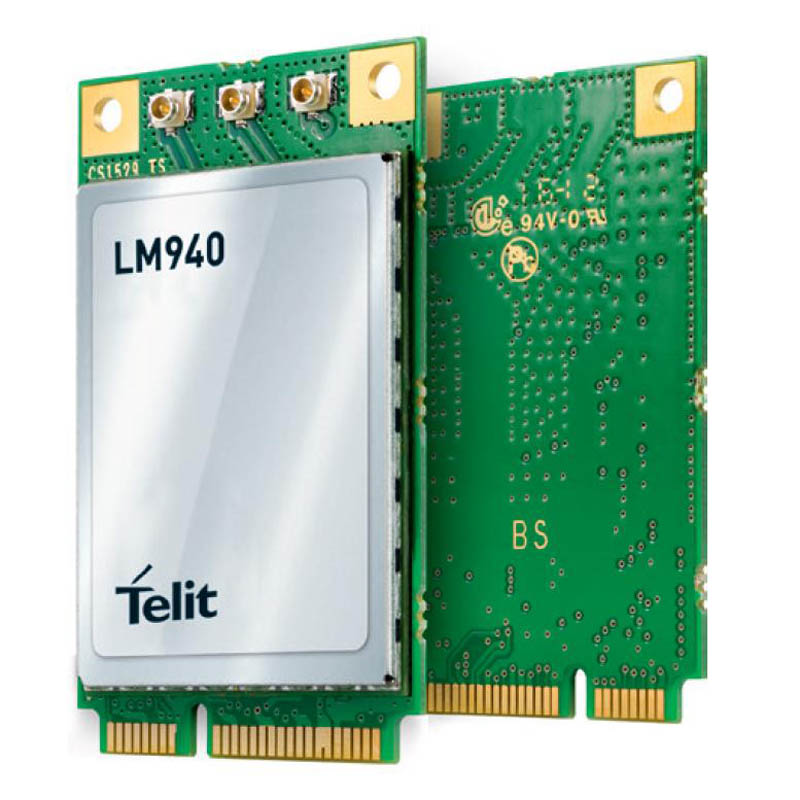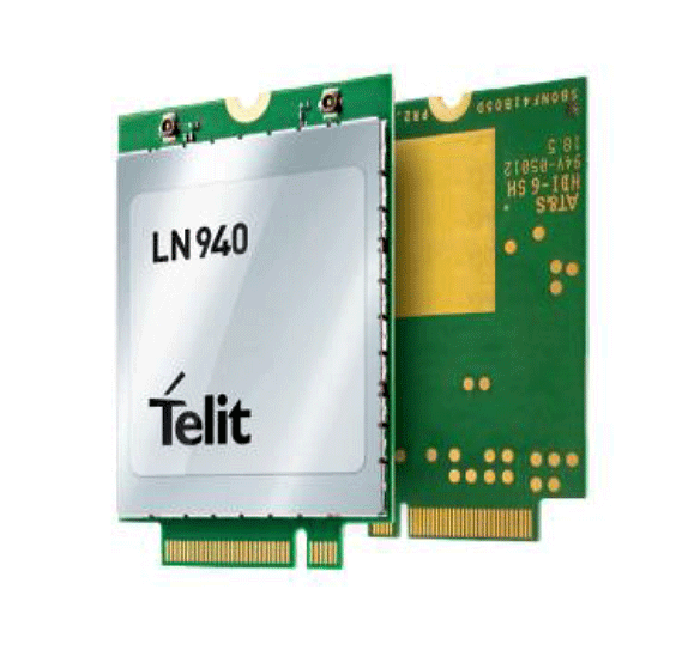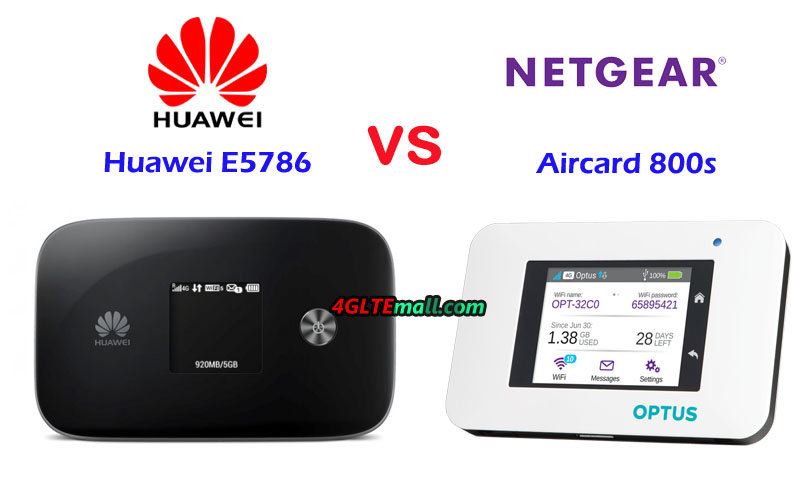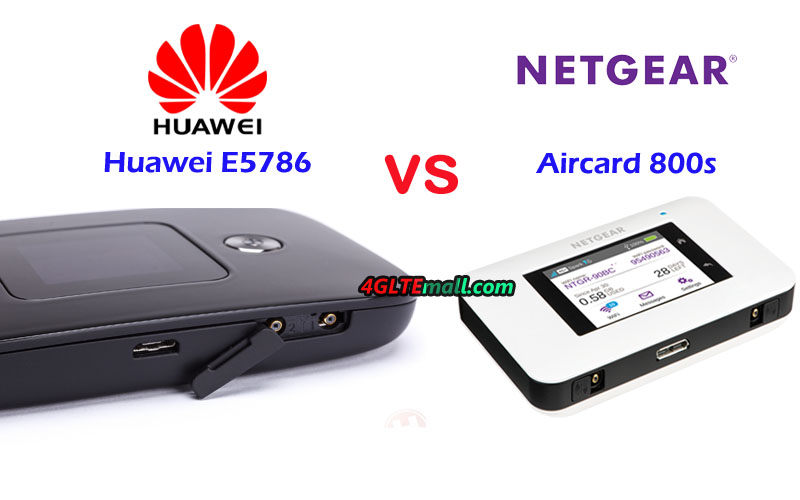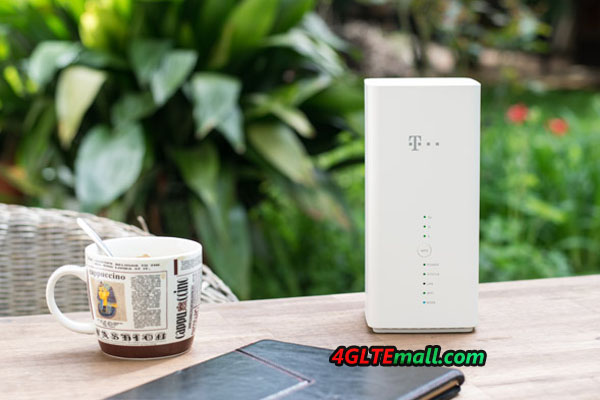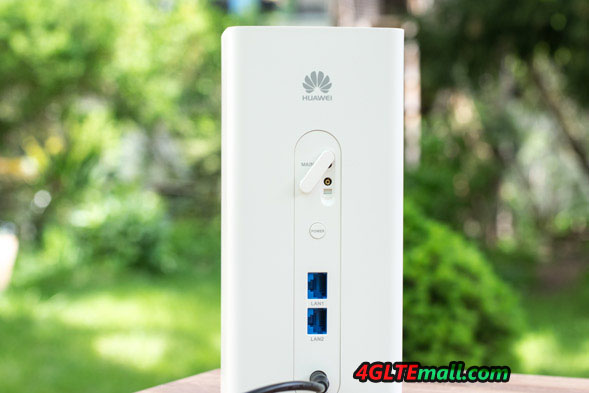huawei LTE modem
-
Telstra 4GX WiFi Pro E5787 VS Optus Modem AC800s
Telstra and Optus are both 4G LTE network providers in Australia, and they provide similar LTE frequency bands. To meet the demand for LTE wireless connection, they both have the 4G LTE mobile WiFi hotspots for their contract plan. Telstra had introduced Huawei E5787 Mobile WiFi touch to its product range while the Optus had latest Netgear Aircard 800s. Then somebody may ask: What’s the difference between Huawei E5787 and Netgear Aircard 800s? Which one is better if buying from the two routers?
Telstra 4GX WiFi Pro E5787 VS Optus Modem AC800s Appearance
The specific model for Telstra is Huawei E5787ph-67a, unlike the brother model Huawei E5786, the E5787ph-67a has a 2.4-inch touchscreen and no button on the front side. The power button is on the top edge side while on the opposite side, the USB 2.0 port and two connectors for external antennas are available. The back cover of Huawei E5787 could be removed for changing the battery or inserting the SIM card.
Like the Telstra 4G WiFi Pro Unlocked, the Optus 4G WiFi modem 800s also has a 2.4-inch touchscreen and there are two buttons at the screen side, one for home and the other for "back". The button is also on the top edge side and the two connectors for external antennas are available at the opposite side with the USB 3.0 port. The difference is the antenna connectors are on two sides of the USB port. The back cover of Optus 800s could also be removed for exchange or inserting the SIM card. They are both configured with two TS-9 connectors.
Optus AC800S VS Huawei E5787 Specs and features
From the appearance, we can see the Telstra 4G WiFi Pro and Optus 4G Cat.9 modem 800s are very similar in design, including the touchscreen, home button, external antenna connectors. Let’s compare the Telstra 4G WiFi Pro specs with Optus 4G modem 800S Specs to see what the difference is in the specifications in the table below:
Model Netgear Aircard 800S Huawei E5787 Product type LTE Mobile Hotspot LTE Mobile Hotspot Category LTE Cat.9 LTE Cat.6 Chipset Qualcomm MDM9240 HiSilicon LTE Cat6 Chipset (Cortex A9 Processor) Data rates DL 450Mbps/UL 50Mbps DL 300Mbps/UL 50Mbps Supported 4G LTE frequency bands B1, B3, B7, B28, B40 * Huawei E5787s-33a: Band 1/3/5/7/8/20 * Huawei E5787Ph-67a: Band 1/3/5/7/8/28 WLAN 802.11a/b/g/n/ac, dual-band 2.4GHz & 5GHz 802.11a/b/g/n/ac, dual-band 2.4GHz & 5GHz Max support users 15 users 10 users MIMO 2 x 2 MIMO 2 X 2 MIMO Connector for external antenna Two, TS-9 jacks Two, TS-9 jacks Buy Antenna Optus AC800s External Antenna Huawei E5787 external Antenna App management Netgear Aircard APP Huawei Hilink APP SIM type Micro SIM Micro SIM Battery 2930 mAh 3000mAh Dimensions 110 x 68 x 16.1 mm 109.00 x 58.00 x 7.50mm Ethernet Port No No Datasheet download Netgear AC800S Datasheet Huawei E5787 Datasheet User Manual Optus 4G modem 800S Manual Huawei E5787 Manual Other features 3 band CA 2 band CA Reviews Netgear Aircard 800s review Huawei E5787 Review Price 199.00USD 299.00USD Summary
From the specs table, we can see the Optus 4G WiFi modem 800s is more advanced than Telstra 4G WiFi Pro E5787 because the Optus modem AC800S could support LTE download speed up to 450Mbps while the Huawei E5787 could only reach LTE download speed to 300mbps. With Qualcomm chipset, Optus 4G modem 800s could support LTE category 9 while Telstra E5787 supports LTE Cat.6 on Huawei Hisilicon LTE Cat.6 chipset. Telstra 4G WiFI Pro could support maximum 10 users to access the internet while Optus 800s would support up to 15 users. The most interesting is that the Optus 4G WiFi modem unlocked price is 199.00USD while the unlocked Telstra 4G WiFi Pro at price of 299.00USD. So if you would buy an unlocked 4G mobile hotspot from the two, it’s obvious that the unlocked Optus 4G WiFi modem 800s is better than unlocked Telstra 4G WiFi Pro E5787.
PR -
Five LTE Advanced Pro Modules to Recommend
With the development of LTE wireless technologies, more and more networks are evolving from LTE advanced to LTE advanced Pro. LTE Advanced Pro (LTE-A Pro, also known as 4.5G, 4.5G Pro, 4.9G, Pre-5G, 5G Project, and so on) is a marker of the 3GPP release 13 and 14, which is a natural evolution of Long Term Evolution (LTE) with speed up to Gbit/s level, which incorporated numerous new technologies that would be used in 5G standard, including 256QAM, Massive MIMO, LTE-Unlicensed, LTE IoT, and others to progressively evolve existing networks into 5G standard.
LTE-A Pro aims to significantly increase the data speeds and bandwidth available for mobile communications. It will also bring a much wider range of connected devices and platforms under a single standard. LTE-A Pro seeks to improve and optimize the capacity, performance, functionality and efficiency of LTE-A, as well as to further reduce latency, to provide a better user experience. It will also enhance the LTE platform for the delivery of new services to new markets as we move towards IoT with 5G. The key attributes that will define LTE-Advanced Pro are: > Data speeds in excess of 3Gbps (LTE-A: 1Gbps) > 640MHz of carrier bandwidth (LTE-A: 100MHz) > Latency: 2ms (LTE-A: 10ms) Since very few LTE Advanced pro devices are available in the market, the LTE vendors are already presenting their LTE advanced Pro modules to the public and below the five LTE advanced Pro modules are recommended if your terminals are demanding high-speed internet access:
- Telit LM960 (LTE Cat.18)
Specs Highlights:
* World's first mPCIe form factor to support LTE cat.18
* Support global 23 LTE Frequency bands
* LTE peak download speed up to 1Gbps
* Dual SIM Single Standby
* Full GNSS support: GPS, GLONASS, Galileo, Beidou
* Chipset: Qualcomm Snapdragon X20 modem
* Linux and Windows driver support
* 4 x 4 MIMO and 256 QAM
* 5x Carrier Aggregation for increased data rates
Check more details about Telit LM960 Specs, price, drivers, and buy Telit LM960 module here: https://www.4gltemall.com/telit-lm960-4g-lte-cat18-pcie-module.html
- Sierra Wireless AirPrime EM7565 (LTE Cat.12)
Specs Highlights:
* LTE Advanced Pro Cat.12 Module
* Chipset/Processor: Qualcomm MDM9250
* DL to 600Mbps/UL to 150Mbps
* Supporting 24 worldwide LTE bands, including LTE-LAA and CBRS
* Satellite Systems: Galileo, Glonass, GPS, Beidou
* Planned Carrier AT&T, DoCoMo, Telstra, Verizon, Vodafone
* Regulatory: CE, FCC, GCF, IC, NCC, PTCRB
Check more details about Sierra AirPrime EM7565 Specs, price, drivers, and buy AirPrime EM7565 module here: https://www.4gltemall.com/sierra-wireless-airprime-em7565.html
- Sierra Wireless AirPrime EM7511 (LTE Cat.12)
Specs Highlights:
* Very similar to AirPrime EM7565
* LTE Advanced Pro Cat.12 Module
* Form factor: M.2
* Chipset/Platform: Qualcomm
* DL to 600Mbps/UL to 150Mbps
* Supporting 24 worldwide LTE bands, including LTE-LAA and CBRS
* Control Options: APIs, AT Commands
* Firmware over-the-air (FOTA)
* GPS, GLONASS, BeiDou, and Galileo satellite systems supported
Check more details about Sierra AirPrime EM7511 Specs, price, drivers, and buy AirPrime EM7511 module here: https://www.4gltemall.com/sierra-wireless-airprime-em7511.html
- Telit LM940 (LTE Cat.11)
Specs Highlights:
* Category: LTE Cat.11 Module
* Form Factor: PCI Express Mini Card Type (mPCIe)
* Chipset: Qualcomm MDM9240
* LTE data rates: DL 600Mbps(w/3x CA DL, 256QAM) and UL 75Mbps
* Full GNSS support: GPS, GLONASS, Galileo, Beidou
* Carrier Approvals: AT&T, Sprint, Verizon
Check more details about Telit LM940 Specs, price, drivers, and buy Telit LM940 module here: https://www.4gltemall.com/telit-lm940-lte-cat-11-gps-pcie-module.html
- Telit LN940 (LTE Cat.11 and Cat.9)
Specs Highlights:
* Two variant models: Telit LN940A9 and LN940A11
* 42mm M.2 (NGFF) single-sided data card
* LTE Category 11 LTE DL 600Mbps UL50Mbps
* LTE Category 9 LTE DL 450Mbps UL50Mbps
* HSPA+ Rel. 8: DL/UL up to 42/11.5 Mbps
* Quad-constellation integrated GNSS
* Linux and Windows driver support
* Carrier Aggregation, 2 x 2 MIMO and 256 QAM
Check more details about Telit LN940 Specs, price, drivers, and buy Telit LN940 module here: https://www.4gltemall.com/telit-ln940-lte-cat9-11-m-2-data-card.html
-
Telstra 4GX Pro VS Optus 4G WiFi Modem 800s
Optus is one of the important network providers in Australia and provides LTE networks in LTE Band 3, 7, 28 and 40. It has introduced the Huawei E5786 4G Mobile hotspots to its product range and now the new product Netgear Aircard 800s available for contract. For those people who are interested in the two mobile hotspots, they may want to know what the difference is between the Huawei E5786 and the Netgear AC800S, and which one is better to buy for global use. We will review the appearance, interfaces, specs, and other features as a reference for the questions.
Huawei E5786 VS Aircard 800s Appearance and interfaces
Huawei E5786 is the first LTE Cat.6 mobile hotspot from Huawei, and the specific model for Optus is Huawei E5786s-63a. Huawei E5786 has a 2.4 inch screen to show the network provider, signal, battery, data consumed, WiFi users, SSID and password, and etc…Like other Huawei 4G pocket WiFi routers, Huawei E5786s-63a has two TS-9 connectors for external LTE antennas. The back cover of Huawei E5786 could be removed to insert the SIM card or SD card. However, the battery of Huawei E5786 is built-in and can’t be removed for exchange. The power button is on the front besides the screen while the menu button is on the top edge side of the device.
Unlike the Huawei E5786, the Netgear Aircard 800s is configured with a touchscreen, where users can do simple setting through the screen. Like other Netgear 4G Pocket WiFi routers, Optus 4G WiFi modem 800s also has two TS-9 connectors for 4G external antennas. However, the back cover of Aircard 800s could be removed for changing the battery and inserting the SIM card, but there is no SD card slot for storage sharing. The Optus AC800S has a USB 3.0 interface.
Netgear AirCard 800s VS Huawei E5786 Specs and features
From the appearance, we can’t see much difference between the two mobile hotspots. The main difference is on the touchscreen. Then let’s have a look at the Huawei E5786 specs and Optus WiFi modem 800S specs for more details comparison:
Model Netgear Aircard 800S Huawei E5786s-63a Product type LTE Mobile Hotspot LTE Mobile Hotspot Category LTE Cat.9 LTE Cat.6 Chipset Qualcomm MDM9240 HiSilicon LTE Cat6 Chipset Data rates DL 450Mbps/UL 50Mbps DL 300Mbps/UL 50Mbps Supported 4G LTE frequency bands B1, B3, B7, B28, B40 B1, B3, B7, B8, B28, B40 WLAN 802.11a/b/g/n/ac, dual-band 2.4GHz & 5GHz 802.11a/b/g/n/ac, dual-band 2.4GHz & 5GHz Max support users 15 users 10 users MIMO 2 x 2 MIMO 2 X 2 MIMO Connector for external antenna Two, TS-9 jacks Two, TS-9 jacks Buy Antenna Optus AC800s External Antenna Huawei E5786 external Antenna App management Netgear Aircard APP Huawei Hilink APP SIM type Micro SIM Micro SIM Battery 2930 mAh 3000mAh Dimensions 110 x 68 x 16.1 mm 106.00 x 66.00 x 15.90mm Ethernet Port No No Datasheet download Netgear AC800S Datasheet Huawei E5786 Datasheet User Manual Optus 4G modem 800S Manual Huawei E5786 Manual Other features 3 band CA 2 band CA Reviews Netgear Aircard 800s review Huawei E5786 Review Price 199.00USD 199.00USD Summary
The specs table above shows the Optus 4G WiFi modem 800s is more advanced based on Qualcomm chipset and the support of LTE Category 9, which could achieve download speed to 450Mbps and upload speed to 100Mbps. With the 3 band Carrier Aggregation, removable battery and touchscreen, Aircard 800s seems better than Huawei 4G LTE E5786 MiFi. And they both support similar LTE Frequency bands. What’s more, the price of Aircard 800s is same as Huawei E5786 price. So if you would buy one 4G mobile hotspot from the two, Netgear Aircard 810s is recommended with higher configuration and better experience.
-
Telekom Speedbox LTE IV (Huawei B618s-22d) Review
Last year, the Germany network provider Telekom puts its logo on a Huawei WiFi router 4G again and assigned the new LTE router as the name of Speedbox LTE IV. If you are familiar with Huawei LTE router, you can immediately recognize the Speedbox LTE IV is from original Huawei B618s-22d router. On the basic hardware of the Huawei B618 Router, Telekom may customize some firmware of the router, but the highlight features are still maintained as below:
Features and characteristics of Speedbox LTE IV (Huawei B618s-22d)
Manufacturer and model number Huawei B618s-22d / Telekom Speedbox LTE IV chipset Balong 75 LTE Category LTE Cat. 11 Download rate Up to 600 Mbps Upload rate Up to 50 Mbps Supported LTE bands 800, 900, 1800, 2100, 2600 MHz Backwards compatible with HSPA+ (42.2 Mbps), UMTS, Edge, GPRS Support of LTE-Advanced Yes MIMO Support Yes Connection for external antenna Yes, two TS-9 connectors (Buy Speedbox LTE IV Antenna) Network | LAN & WLAN
LAN ports: 2 WLAN standards: WLAN 802.11 a/b/g/n/ac 5 GHz WLAN support: Yes Encryption: WEP, WPA, WPA2, WPS WLAN hotspot function: Yes Others
Battery pack no battery available Dimension 95 x 95 x 210 mm USB two USB ports Memory card expansion No Release November 2017 Price: 449USD (as of April 2018) available at: » www.4gltemall.com Docs download
Datasheet: » Download Huawei B618 Datasheet (PDF, 190 KB) Detailed manual: Download Huawei B618 Manual (PDF) Huawei knows a lot about the network business, so it's no wonder that local operators often rely on solutions from this company. Based on the LTE category 11, the redesigned router B618s-22d is particularly future-proof. Up to 600 Mbit/s can be achieved in the download, in the upload a maximum of 50 Mbit/s is possible. To ensure good 4G reception, Huawei has integrated the multi-antenna technology 4 × 4 MIMO. However, if the LTE network is not available, the data can also be transmitted via HSPA with a peak bandwidth of 42.2 Mbit/s. Backward compatibility with 2G radio (GSM / GPRS) finally provides the last straw in mobile communications. Regarding the LTE frequency bands, the Speedbox LTE IV covers all relevant frequency bands on B1, B3, B7, B8, B20.
Interfaces of the Speedbox LTE IV
A good LTE reception at the router is of course only half the task, the data packets must also be forwarded accordingly quickly and efficiently to the terminals. With the Wifi connection 802.11 ac, smartphones, tablets and notebooks can benefit from a fast connection. Thanks to dual-band (2.4 GHz and 5 GHz), up to 1.9 Gbit/s are possible. Alternatively, an Ethernet connection is available via two Gigabit-capable LAN ports. In terms of USB, the Telekom has upgraded with his variant. The original model "Huawei B618s-22d" comes only with a USB port and high-quality telephone is also possible with this router, however, the Speedbox LTE IV gets with only two LAN ports. A telephone system does not exist, but the Huawei B618 router is originally VoLTE- compatible and can handle VoIP. The Telekom Speedbox LTE IV has cut the telephone function.
Special features of the Speedbox LTE IV
If the reception is not sufficient, the buyer can use an external antenna solution. The SIM card slot is a bit out of date and comes in the micro-SIM version. If necessary, an adapter must be used. An integrated firewall provides the necessary security, and the router can be configured via a web interface.
The package content consists of a plug-in power supply, a LAN cable and a quick start guide. The maximum power consumption of the Speedbox LTE IV is 24 watts. The price of Speedbox LTE IV is not cheap now. If you want to get an unlocked device, we suggest you take the original Huawei B618s-22d with the WAN & LAN ports, and the USB & VoIP telephone ports.
-
Huawei Router WiFi E5186 VS B593
As a top network solution provider, Huawei LTE Gateways are an important series of wireless products for home or office networking. Huawei B593 is the world’s first 4G LTE WiFi routers with Ethernet port and the new competitors are continuously presented to the public by Huawei in following years. Huawei E5186 wireless router is one of them. If you want to change the 3G router or ADSL connection to Huawei 4G Gateway, you may ask: what’s the difference between the Huawei B593 and Huawei E5186? Which one is better in performance? In this article, we will review the appearance, interfaces, specs and variant models to provide possible answers for you.
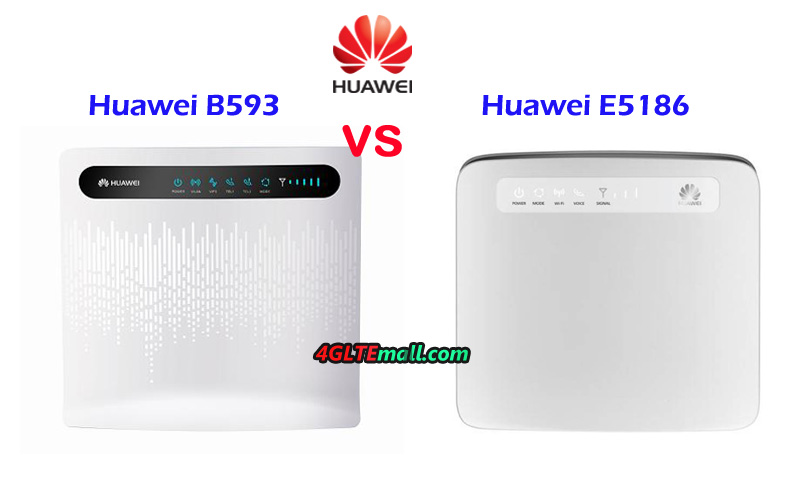 Huawei E5186 VS B593 Router Appearance and Interface The Huawei 4G Router B593 and E5186 are both the 4G WiFi router with Ethernet ports in traditional router shape. On the front of Huawei B593 LTE CPE, there are some indicators for Power, WLAN, WPS, Telephone, Mode, and Signal. On the Huawei E5186, it indicates Power, Mode, WiFi, Voice, and Signal. Of course, Huawei logo is with the indicators. On the back, they both have two connectors for an external antenna. The connector type is SMA. They can use the same 4G LTE External Antenna.
Huawei E5186 VS B593 Router Appearance and Interface The Huawei 4G Router B593 and E5186 are both the 4G WiFi router with Ethernet ports in traditional router shape. On the front of Huawei B593 LTE CPE, there are some indicators for Power, WLAN, WPS, Telephone, Mode, and Signal. On the Huawei E5186, it indicates Power, Mode, WiFi, Voice, and Signal. Of course, Huawei logo is with the indicators. On the back, they both have two connectors for an external antenna. The connector type is SMA. They can use the same 4G LTE External Antenna. 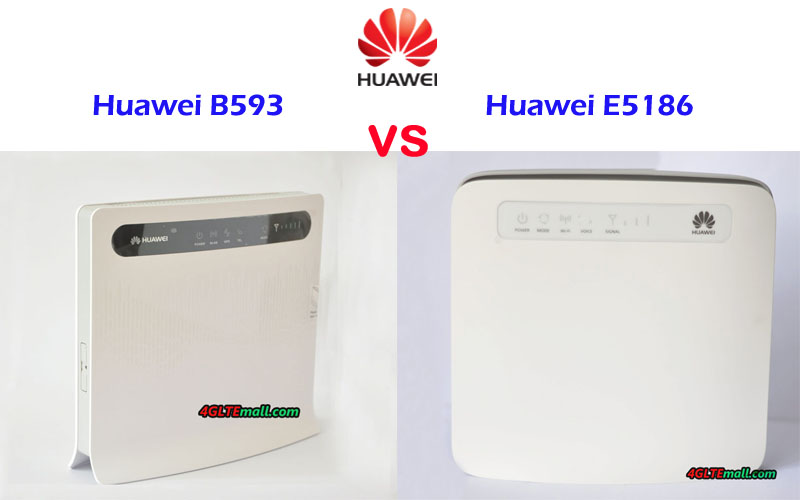 On the back, there is also a line of interfaces, including 4G LAN port(one for WAN/LAN), two telephone port, one USB 2.0 port and power plug port. On the Huawei E5186, there is a power button to switch on or off the power. Huawei B593 power button is at the side of the SIM card slot. The Huawei E5186 SIM card slot is also at the body side with the WPS and WIFI button. Huawei E5186 uses Micro SIM card while the first generation LTE router B593 uses standard SIM card.
On the back, there is also a line of interfaces, including 4G LAN port(one for WAN/LAN), two telephone port, one USB 2.0 port and power plug port. On the Huawei E5186, there is a power button to switch on or off the power. Huawei B593 power button is at the side of the SIM card slot. The Huawei E5186 SIM card slot is also at the body side with the WPS and WIFI button. Huawei E5186 uses Micro SIM card while the first generation LTE router B593 uses standard SIM card. 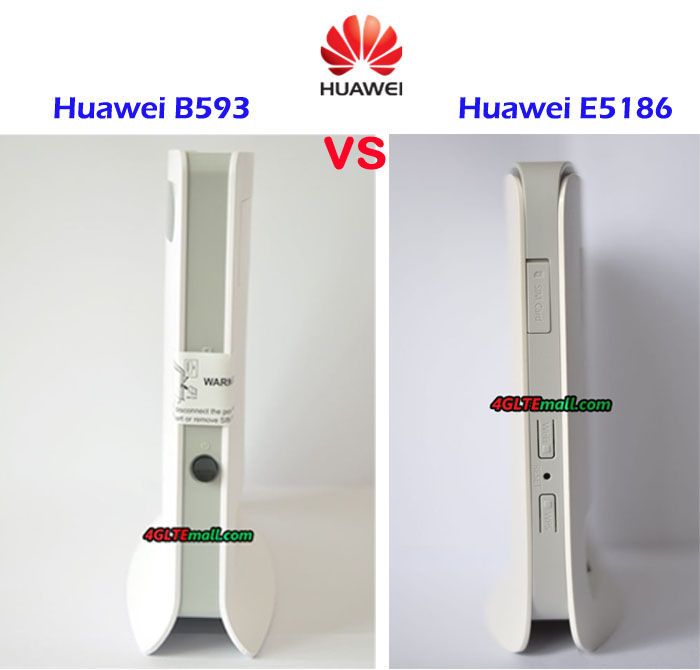 Huawei B593 VS E5186 Specs and variant models From the specs, we can’t see much difference between the two Huawei routers. Actually, as the upgraded version of Huawei B593, Huawei E5186 almost followed the design of Huawei B593 and has just little adjustment. To meet the different LTE frequency bands worldwide, Huawei had assigned many variant models for LTE CPE B593, such as B593u-12, B593s-22, B593s-82, B593u-91, B593s-850, B593s-601, B593s-516, B595s-931 etc… Huawei E5186 also has two variant models: E5186s-22a and E5186s-61a. You can check details specs of the variant models on the product page. And below the table shows the details specs of Huawei E5186 and Huawei B593 Router for reference:
Huawei B593 VS E5186 Specs and variant models From the specs, we can’t see much difference between the two Huawei routers. Actually, as the upgraded version of Huawei B593, Huawei E5186 almost followed the design of Huawei B593 and has just little adjustment. To meet the different LTE frequency bands worldwide, Huawei had assigned many variant models for LTE CPE B593, such as B593u-12, B593s-22, B593s-82, B593u-91, B593s-850, B593s-601, B593s-516, B595s-931 etc… Huawei E5186 also has two variant models: E5186s-22a and E5186s-61a. You can check details specs of the variant models on the product page. And below the table shows the details specs of Huawei E5186 and Huawei B593 Router for reference: Model Huawei E5186 Huawei B593 Product type LTE WiFi Router LTE WiFi Router Category LTE Cat.6 LTE Cat.3 Chipset HiSilicon LTE Cat6 Chipset Qualcomm MDM9200 Data rates DL 300Mbps/UL 50Mbps DL 100Mbps/UL 50Mbps Supported 4G LTE frequency bands E5186s-22a: Band 1/3/7/8/20/38 E5186s-61a: Band 3/7/28/40 * B593u-12: Band 1/3/7/8/20 * B593s-22: Band 1/3/7/8/20 * B593s-82: Band 38/40 * B593s-601: Band 3/7/40 * B593s-516: LTE FDD Band 2/4/5/7/8 WLAN 802.11a/b/g/n/ac, dual-band 2.4GHz & 5GHz 802.11b/g/n, dual-band 2.4GHz Max supported users 64 users 32 users MIMO 2 x 2 MIMO n/a Connector for external antenna Two, SMA-female jacks Two, SMA-female jacks Buy Antenna Huawei E5186 external antenna Huawei B593 External Antenna App management Huawei Hilink APP Huawei Hilink APP SIM Size Micro SIM Stand SIM Battery NO NO Dimensions 190 mm × 200 mm × 32 mm 190 mm x 35 mm x 176 mm Interfaces * 3 x LAN port(45) * 1 x LAN/WAN port (45) * 2 x telephone port(RJ11) * Two external LTE antenna ports (SMA-J1.5) * One micro-SIM card slot * 1 x USB 2.0 port * 3 x LAN port(45) * 1 x LAN/WAN port (45) * 2 x telephone port(RJ11) * Two external LTE antenna ports (SMA-J1.5) * One stand SIM card slot * 1 x USB 2.0 port Datasheet Huawei E5186 Datasheet(PDF) LTE CPE B593 Datasheet User Manual Huawei E5186 User Manual(PDF) LTE CPE B593 Manual Other features Firewall, CS Voice, VoIP, TR069 Remote Management, HTTP Online Upgrade, QoS, USB Share, UPnP, IPV6, DLNA, Fax, Print, VPN DHCP, Firewall, URL filter, LAN MAC filter, IP Filter, DMZ, Port forwarding Reviews Huawei E5186 Review Huawei B593 Router Review 449.00USD 259.00USD 189.00USD 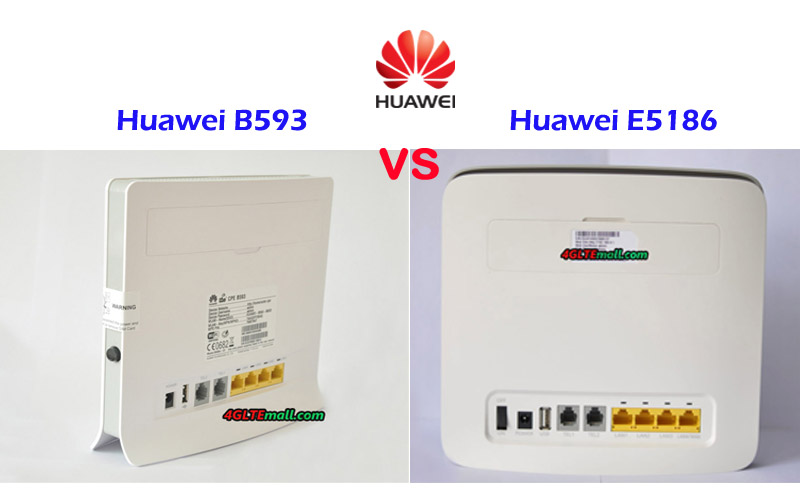 Huawei E5186 VS B593 Speed Test If you want to know the real speed performance of the two router, check the Huawei E5186s-22 vs Huawei B593u-12 speed test: [embed]https://youtu.be/qUHrShcHQvI[/embed] Summary From the specs table, we can see the Huawei E5186 is more advanced which could support up to 300Mbps download speed thanks to LTE Cat.6 with 2 x 2 MIMO and carrier aggregation technology. The speed is almost three times faster than the speeds of Huawei B593 router. The interfaces features are very similar in the two Huawei LTE Router with Ethernet ports. Huawei E5186 WiFi router could support maximum of up to 64 users, which is the double quantity of that on Huawei B593 router. So if you want to buy a fast 4G router, the Huawei E5186 would be the right one. The advantage of Huawei B593 router is that it has many variant models for more LTE frequency bands, if you are looking for a router for specific bands, you may find one in LTE B593 variant models. And the Huawei B593 price is much cheaper than the price when it’s first available in the market. And it’s also much cheaper than Huawei E5186 price. If you don’t have enough budgets for Huawei LTE CPE E5186, then Huawei B593 would provide 4G speed for your internet access.
Huawei E5186 VS B593 Speed Test If you want to know the real speed performance of the two router, check the Huawei E5186s-22 vs Huawei B593u-12 speed test: [embed]https://youtu.be/qUHrShcHQvI[/embed] Summary From the specs table, we can see the Huawei E5186 is more advanced which could support up to 300Mbps download speed thanks to LTE Cat.6 with 2 x 2 MIMO and carrier aggregation technology. The speed is almost three times faster than the speeds of Huawei B593 router. The interfaces features are very similar in the two Huawei LTE Router with Ethernet ports. Huawei E5186 WiFi router could support maximum of up to 64 users, which is the double quantity of that on Huawei B593 router. So if you want to buy a fast 4G router, the Huawei E5186 would be the right one. The advantage of Huawei B593 router is that it has many variant models for more LTE frequency bands, if you are looking for a router for specific bands, you may find one in LTE B593 variant models. And the Huawei B593 price is much cheaper than the price when it’s first available in the market. And it’s also much cheaper than Huawei E5186 price. If you don’t have enough budgets for Huawei LTE CPE E5186, then Huawei B593 would provide 4G speed for your internet access.

